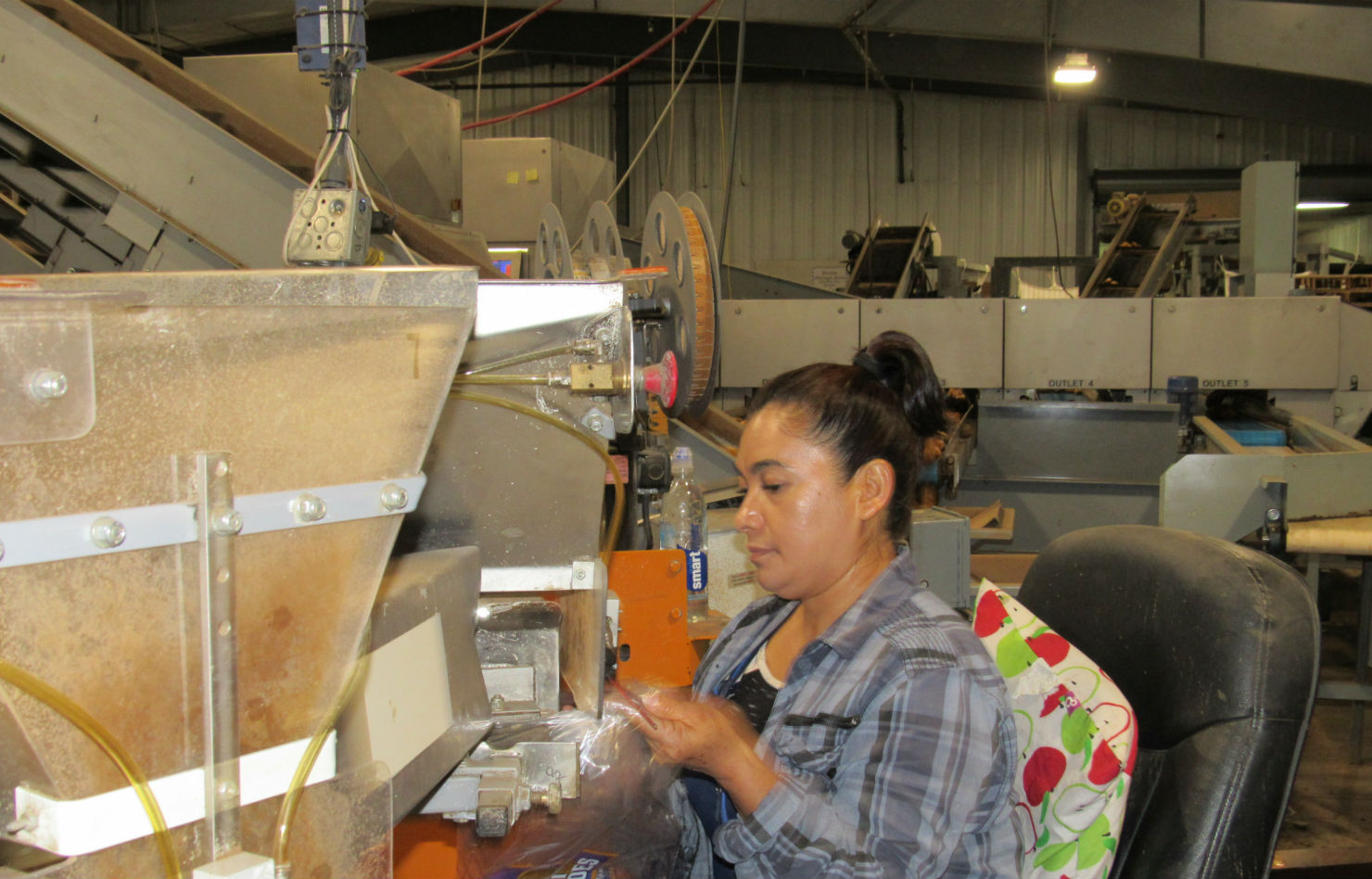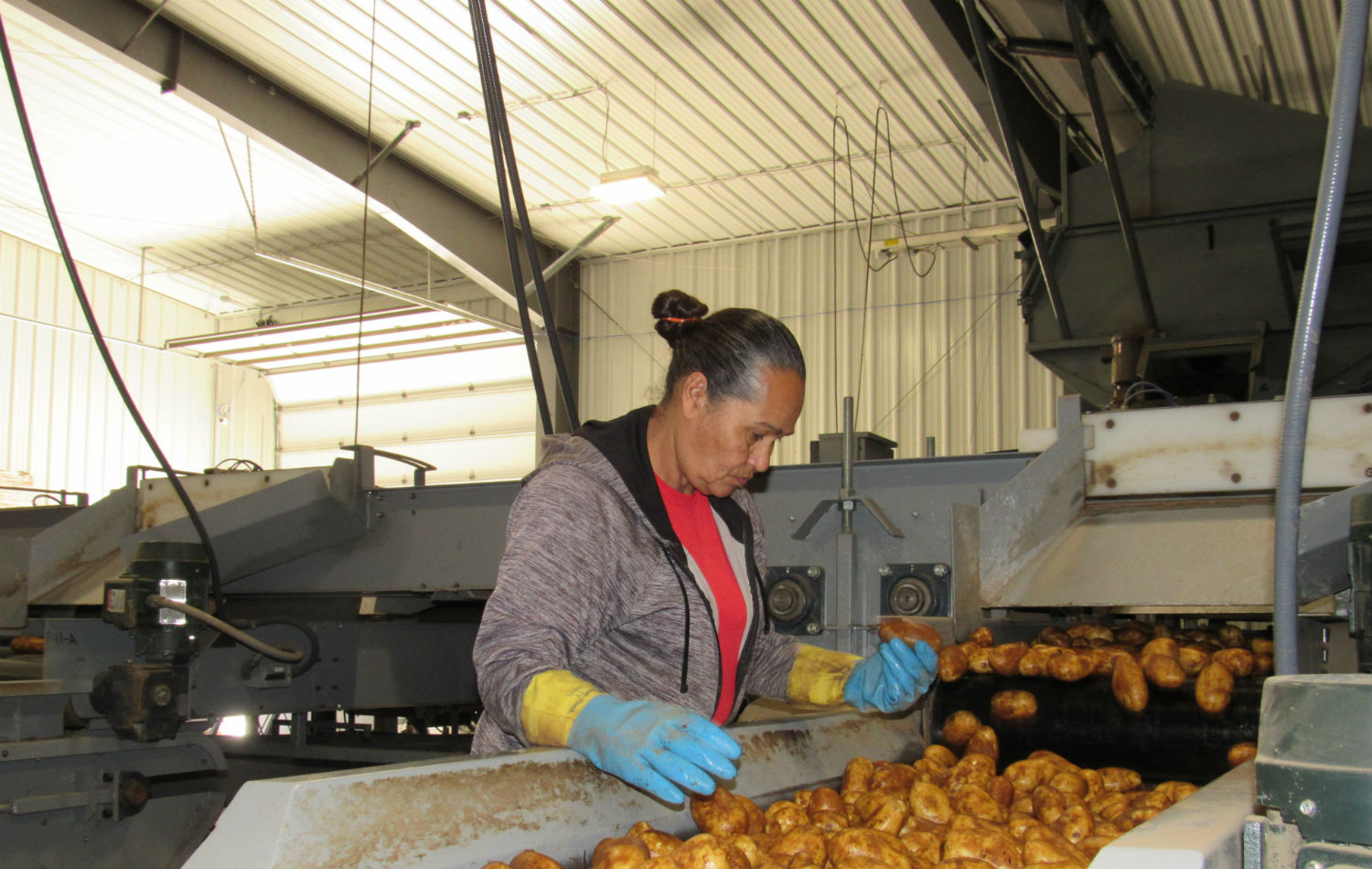The brewery is part of a 300-acre farm which grows grains and hops, and which also operates a malting company. Wayne Cody, the farm’s 61-year-old patriarch, has just come in from hours of work, roasting malt, examining fields, and preparing to plant buckwheat the next day.
As he visits with customers, it’s clear that most people in this bar tonight know that something almost unholy is in the works here in the San Luis Valley.

Deb Anderson tends bar at the Colorado Farm Brewery June 6, 2019.
A well-connected metro Denver water developer, backed by former Colorado Governor Bill Owens, Front Range real estate interests, and absentee ranchers who themselves control huge amounts of water here, is proposing to export millions of gallons of water out of this drought-stricken, scrappy place for delivery to fast-growing Douglas County.
Sean Tonner, who once served as deputy chief of staff for Owens, is leading the group, which has proposed spending $118 million to acquire water from the farmers here. That sum includes a $50 million community fund to help bolster the poverty-stricken region.
Tonner’s company, known as Renewable Water Resources, is at least the fourth in a stream of developers who’ve beaten a path to this remote region in the past 50 years, intent on harvesting its water. All, up until now, have been decisively turned back.
In February, at a water conference in Alamosa, just up the road from Henry, a man suggesting that Tonner’s proposal had merit was booed.

The proposal to bring water from the San Luis Valley to the metro area would require a pipeline of more than 200 miles. Credit: Chas Chamberlin
Former U.S. Senator Ken Salazar’s family has farmed here for generations. Salazar also spoke at the conference and reassured the 200-plus people in the packed auditorium that no water would ever flow out of the valley into the metro area.
“Over my dead body,” he said to cheers and applause.
In a minute
For Wayne Cody, it isn’t nearly that clear cut. He and his sons, an energetic, muscular lot, are pouring everything they have, including beer, into saving their family farm.
Cody’s grandparents bought the farm in the 1930s, and the family has grown alfalfa profitably, then raised dairy cows, again profitably, for some 80 years. But as farm costs rose, and dairy prices dropped, they turned to a new industry, brewing, with Coors and others as customers.
In 2008, they started the Colorado Malting Company and last year they opened the Colorado Farm Brewery on County Road 12 South. Its custom beer snifters urge guests to “Drink Like A Farmer.”

Wayne Cody bags malt for shipment to a distillery in Longmont, Colo. He and his sons are seeking ways to keep the family farm profitable, even as farm incomes erode. June 7, 2019 Credit: Jerd Smith
Until a corporate malting company entered the valley two years ago, the Cody clan was selling 1 million pounds of malt a year, but they haven’t been able to compete well with the big operation, and so this year they have contracts to sell just 600,000 pounds of malt, Wayne Cody said.
Last month, the family laid off a full-time and part-time employee. Still they’re pushing ahead, hoping to make inroads into California’s malt market.
In the interim, the notion of selling some of their water each year to generate additional cash has a certain appeal.
“I would hate to see the water leave the valley,” Cody said, “but would I sell some? In a minute.”
Unequivocally no
Eight miles north, in Alamosa, Cleave Simpson runs the Rio Grande Water Conservation District, an agency created by state law in 1967 to manage the Rio Grande River. It serves roughly 1,000 farm entities in the valley. Simpson and others are deeply worried about the export plan because the valley’s water supplies are already under severe stress.
The region’s sprawling farm economy is supported by the Rio Grande River and a giant underground aquifer, a sort of bathtub that is refilled by snowmelt and runoff.
But the aquifer has been over-pumped and hasn’t been able to refill itself for decades, thanks largely to the giant thirst of the valley’s thriving potato industry. It is the second-largest potato growing region in the United States.

A conveyor sorts potatoes at the Monte Vista Potato Growers’ facility in Monte Vista. June 7, 2019 Credit: Jerd Smith
A stubborn 19-year drought, that broke at least temporarily this year, and a warming climate that is causing declines in western rivers are compounding the problem.
So depleted is the aquifer that the state has ordered the valley to bring water levels back up to where they were prior to 2000, or face a massive shut down of farm wells in 2030.
It wasn’t always like this. When farmers began drilling powerful irrigation wells into the aquifer in the 1950s, subsurface water was thought to be so plentiful that they could irrigate their fields almost endlessly. But as modern hydrology caught up with pumping technology, it became clear that there was a close connection between the aquifer and flows in the river, and that the pumping was harming the aquifer, the river, and other farmers’ water rights in the river.
Soon, the Rio Grande Basin was under legal fire. Eventually the courts determined that the farmers of the San Luis Valley were overusing their fair share.
Still, bringing the aquifer back into balance is no small task. To get it done, valley farmers are voluntarily taxing themselves, and using those revenues to pay other farmers to reduce their pumping and fallow fields. But last year’s drought stripped the Rio Grande River of much of its water, and forced the farmers to pump heavily to protect their crops, wiping out much of the water their voluntary conservation program had placed underground in the prior seven years.

Source: Rio Grande River Water Conservation District. Credit: Chas Chamberlin
Now, even in a good water year like this one, the valley must pay back the water it has overused in the past so that the Rio Grande can be made whole as it flows south to irrigate fields in New Mexico and Texas and refill reservoirs for the citizens and farmers of those states.
It is a bitter reality in the San Luis Valley, one that makes the notion of outsiders taking even more water out of the depleted region particularly painful to many of its farmers and water officials.
“This basin is just highly over-appropriated,” Simpson said. “There are way more decrees for water rights than can be delivered in any one year. We have water rights that haven’t been able to draw from the river in 20 years. Likewise the groundwater system is also over-appropriated.”
Tonner and his team made a presentation to the district’s board in January, asking that the district support its export proposal and help manage the $68 million water purchasing effort.
That’s big money down here. But the district’s board said no. Unequivocally no.
Simpson and other water leaders here believe that most farmers will oppose any Front Range deal to export San Luis Valley water, no matter the dollar figures involved.
Town by town
Tonner is not discouraged.
Since last October, he’s been traveling the mountain passes and dusty two-lane highways that link the San Luis Valley to the Front Range, bringing his 11-slide PowerPoint presentation to the tiny towns of the valley, from Saguache to Moffat to Crestone.

Sean Tonner, a principal with Denver-based Renewable Water Resources, is leading a group of investors who want to export water from the drought-stricken San Luis Valley. June 25, 2019. Credit: Jerd Smith
His plan: To buy 22,000 acre-feet of water, a purchase that would dry up roughly 10,000 acres of farm fields and provide enough water for some 44,000 urban homes annually.
He also proposes paying more farmers to fallow enough land to forego the use of another 30,000 acre-feet of water, allowing it to remain in the vast, complex underground water system. According to RWR’s math, even after their 22,000 acre-foot export, ensuring that 30,000 acre-feet is no longer pumped means an 8,000 acre-foot net gain for the system.
Tonner’s Renewable Water Resources is only the latest company to attempt this controversial task. Three others have tried since the 1980s. Tonner was involved with an earlier effort that stalled out due to a ranch owner’s death. Tonner and his backers came back and bought that ranch and are now moving forward with RWR.
RWR says it has raised $28 million from private investors to help fund the deal, but documents on file with the U.S. Securities and Exchange commission indicate that $750,000 has been raised. Tonner said those figures are out of date and that the rest of the money will come once the company has signed a deal with an “end user” in Douglas County.
He says no agreement has been signed yet, but that the end user would need to sell enough bonds to pay the farmers, RWR, and the cost of the massive well fields, pipeline and delivery system that will be needed to bring the water up Highway 285 and across to the Front Range. How much money is that? Tonner estimates construction costs of more than $600 million, depending on the final route of the proposed pipeline.
Tonner said he has signed sale agreements from roughly 40 farmers and that more than 100 farmers have approached him about selling their water. Tonner declined to identify them, citing the tensions in the valley and the potential for public backlash. Wayne Cody is not among them.
But Jerry Berry, a local ranch manager in the town of Moffat who has an ownership interest in RWR, did agree to talk about the proposal.
“This is an 8,000 acre-foot net gain. How does that not benefit the aquifer? You have to be open minded enough to see where the true benefits are. $50 million in a trust fund that they can use for economic growth is more than that water would ever produce agriculturally,” Berry said.
Berry, who is on the local school board, said he believes RWR is looking for a deal that benefits all parties. “I’ve done business with these guys. They are reputable. If it’s not a win-win for everybody they won’t do it.” Other developers, says Berry, have gone straight to water court without seeking community input.
And they’ve all been defeated there.
Having fought off water-hungry invaders before, the San Luis Valley, aided by such powerful politicians as Salazar and former U.S. Senator Tim Wirth, among others, and such powerful environmental groups as The Nature Conservancy, has established a long list of protections that will make any kind of a water export proposal difficult to execute.
Still farmers are entitled to sell their water rights under Colorado law, even if their neighbors disagree.
Insatiable thirst
In his quest to protect the farmers in his district, Simpson too has been traveling the state and in February briefed Colorado’s Interbasin Compact Committee, a group created in 2005 under Colorado state law to facilitate cooperation between river basins.
Jeris Danielson, a former Colorado water regulator who sits on the IBCC, said the RWR proposal exemplifies a long-standing problem in Colorado — how to protect the state’s individual river basins, while ensuring the seemingly endless thirst of the Front Range, whose South Platte and Arkansas basins are also stretched beyond capacity can be satisfied.
“The problem is the six-county sucking chest wound called the metro area,” said Danielson, who represents the Arkansas River Basin on the IBCC. “That’s where all of the people are moving. So how do we solve this problem?”
Transbasin diversions (TBDs), which move water from one river basin to another, are not new in Colorado. More than two dozen pipelines have been harvesting West Slope water and delivering it to the drier Front Range for nearly 150 years, often leaving some of the state’s most scenic, fragile mountain areas and wetlands forever altered.
However, they have become so controversial, and expensive, that no new ones have been built since the 1980s. And Governor Jared Polis, when he was campaigning last summer, said he would do everything in his power to stop any newly proposed TBD.
But that doesn’t address Colorado’s urban thirst. The Front Range needs roughly 300,000 acre-feet of water by 2050 to stave off shortages, according to the Colorado Water Plan. In Douglas County, the number is smaller but the problem is more urgent. Douglas County, along with parts of El Paso and Elbert counties, relies on an aquifer that, unlike the one in the San Luis Valley, cannot renew itself. And aquifer levels are dropping. Cities such as Castle Rock rely on the aquifer for roughly 70 percent of their water, and though they have acquired some surface water rights and they operate a water recycling plant, they still need more fresh water to ensure they don’t drain their own underground supplies.
Will new surface water come from the San Luis Valley? That’s not clear yet.

Construction workers build a single family home in Castle Rock. The city needs new surface water supplies to reduce its reliance on non-renewable groundwater. Credit: Jerd Smith
“RWR has presented to us,” said Castle Rock Director of Utilities Mark Marlowe. “But it’s not part of our long-term plan at this point.”
Tonner said RWR has talked with several major water districts in Douglas County, including Castle Rock and Parker and, very early on, Colorado Springs. But he says he’s not ready to identify the lead water district in the deal thus far.
Marlowe says it isn’t Castle Rock, but that the city might be interested in the plan if the price was right and if there was local support for the proposal in the San Luis Valley.
Colorado Springs said it has not met with RWR and it will not participate under any circumstances, planning instead to pull more water from places such as the Colorado River, where it already has some supplies.
$50 million worth of indifference
Jason Anderson is a Saguache County Commissioner. If this export plan becomes a reality, the well field and pipeline for the project would be built within his district. Saguache is one of the poorest counties in Colorado, with a median household income of $34,765, according to the U.S. Census Bureau.
Across the Continental Divide, in Douglas County, that figure is $111,000. The chasm between rich and poor isn’t lost on anyone in the San Luis Valley.

Cattle have their evening meal in the San Luis Valley. June 6, 2019. Credit: Jerd Smith
“It seems like every five years or so, the Front Range tries to figure out how to tap our water,” Anderson said. “I’m trying to keep an open mind because some of the folks in the proposal are from Saguache County. On the other hand, I haven’t had many folks speak to me in a positive manner about the plan.”
So far, Anderson said, the proffered $50 million community development fund, which might be used to support food banks and new industry, hasn’t swayed public opinion, despite the region’s poverty.
“That $50 million doesn’t seem to be playing much of a role in anyone’s decision down here,” he said.
But a look at Front Range water prices makes clear why there is so much pressure to find more and sell it on the Front Range. RWR says it is willing to pay double the market price for an acre-foot of San Luis Valley farm water. That’s roughly $2,000-plus 3,000.
That same acre-foot of water piped east across the mountains would easily sell for ten times that. And in some communities, $30,000 an acre-foot is a blue-light special.
RWR’s Tonner says his backers are now examining whether they can create an additional financial incentive for farmers that could include a sort of annual royalty payment in addition to the economic development fund.
“Look,” said Tonner, “I’ve had some people say we should pay them $1 billion for their water. That’s not going to happen. But we are trying to put some bones on a proposal that would include an annual royalty payment.”
Tonner said he would go public with his plan in six months and begin making presentations to the public water roundtables in the San Luis and in metro Denver.
Once it starts
Among locals, though, there is a much bigger concern than the cash behind the deal. The worry is that if another pipeline is built to the metro area, it will be only the first in a series of urban water exports that sooner or later will permanently strip the region of its agricultural economy and its proud farm culture.
“There is a reality that when you take the water that is being used in the San Luis Valley and open up a 22,000 acre-foot spigot — I can guarantee in 20 years it opens up to 220,000 acre-feet,” Salazar said in February at the Alamosa water conference. Salazar did not respond to requests for comment for this article.
Tonner says his backers have agreed that they will insert into any eventual water court decree an absolute limit of 22,000 acre-feet on their export plan. But that would not necessarily limit others from using the same pipe to export more water, said David Robbins, an attorney who represents the Rio Grande Water Conservation District.
“I don’t care what RWR says, no one is going to build a pipeline out of the valley and simply take 22,000 acre-feet. That is absurd. You would have to be so insanely naïve as to believe in the tooth fairy. Once it starts, it never stops,” Robbins said.
Saving a farm

A sign at the Colorado Farm Brewery pays homage to the farm. June 7, 2019. Credit: Jerd Smith
Out in Henry, the Cody family has grown accustomed to hard work and risk. In recent weeks, they’ve unveiled a new lager and brought in beer steins to sell. It’s not clear that any of this will sustain the farm.
But if selling a small portion of their water and deriving an annual royalty payment from it could help, Wayne Cody might consider such a proposal.
“Everything we’ve done here is to save this farm,” he said. “Selling some of the water is the most profitable thing I could do.”
Clarification: An earlier version of this article failed to make clear that 22,000 acre -eet of water is enough to serve roughly 44,000 urban homes annually.
Jerd Smith is editor of Fresh Water News. She can be reached at 720-398-6474, via email at jerd@wateredco.org or @jerd_smith.
Fresh Water News is an independent, nonpartisan news initiative of Water Education Colorado. WEco is funded by multiple donors. Our editorial policy and donor list can be viewed at wateredco.org.







 Print
Print